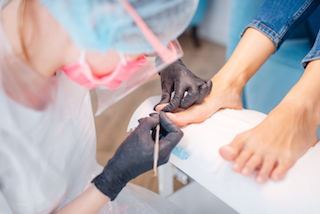Do your nails grow into your skin making it painful to put shoes on? Does the tip of your toe hurt when the bedsheets press against it? Maybe you get redness, swelling and pus leaking down the side of your nail?
You may have an ingrown toenail that needs medical or surgical attention.
Ingrown toenails can be very painful and if they are left untreated they can cause other health concerns such as infection or even ulceration.
Our podiatrists can treat ingrown toenails both conservatively and through minor surgery. They will assess the severity of your ingrown toenail, gather a thorough medical history and then discuss treatment options.
What does a nail avulsion (surgery) involve?
Minor toenail surgical procedures is called a ‘nail avulsion’. This involves removing either a section of the nail or the whole toenail under a local anaesthetic.
There are two types of nail avulsion surgeries that can be performed. One called a Partial Nail Avulsion (PNA), this is the most common procedure and involves only the edge of the nail being removed. The second is called a Total Nail Avulsion (TNA) and this involves the whole nail being removed.
Both of the surgeries are performed under a local anaesthetic to numb the toe being operated on. Once the toe is numb a tourniquet is placed on the toe to control bleeding. For a PNA the nail is released and cut down the length of the nail edge and removed from the nail matrix (base of the nail). A TNA procedure involves the entire nail being lifted and removed from the nail matrix. Once the nail is removed a chemical called Phenol is applied to the area to prevent nail growth (NOTE: not all health professionals do this). If this chemical is not used the nail will regrow and it is likely to become ingrown again.
The tourniquet will then be removed from the nail and the toe soaked with betadine and dressed with a sterile dressing. The procedure is done gently so no stitches will be required. The patient will then be provided with a home care pack and advised on their home-care instructions, which will involve re-dressing the toe. The patient will also be required to attend follow-up appointments so the podiatrist can ensure the surgery site is healing adequately.
Overall the surgery will require a one-hour consultation and the patient will be able to walk on it immediately. We do not advise driving after the surgery, however, as the toe is numb. The expected recovery time is anywhere from 3-8 weeks depending on the overall health of the patient.
Risks involved:
As with any surgery, there are risks of complications associated with the procedure. Although this procedure is safe and effective, it is important to outline and risks associated. Our podiatrist will evaluate your ingrown toenail and your overall health to determine whether or not you would be a good candidate to have the operation. It is important to inform your podiatrist of ALL medical conditions and medications you have, as these can sometimes be associated with complications. All the risks are discussed prior to any procedure being undertaken.
Will Private Health Insurance Cover Podiatry Surgical Fees?
If you have “extra” that includes Podiatry services as part of your private health insurance policy, chances are, you may be eligible for a rebate. To check, contact your health insurance company directly (as we won’t be given access to your private information) and ask what rebate you can expect for the following item numbers:
Partial Nail Avulsion: Item Number 546
Total Nail Avulsion: Item Number 547
Additional Side: Item Number 548
To view our fees click here
If you think you might have an ingrown toenail, book in with our Podiatrist to discuss your options.


